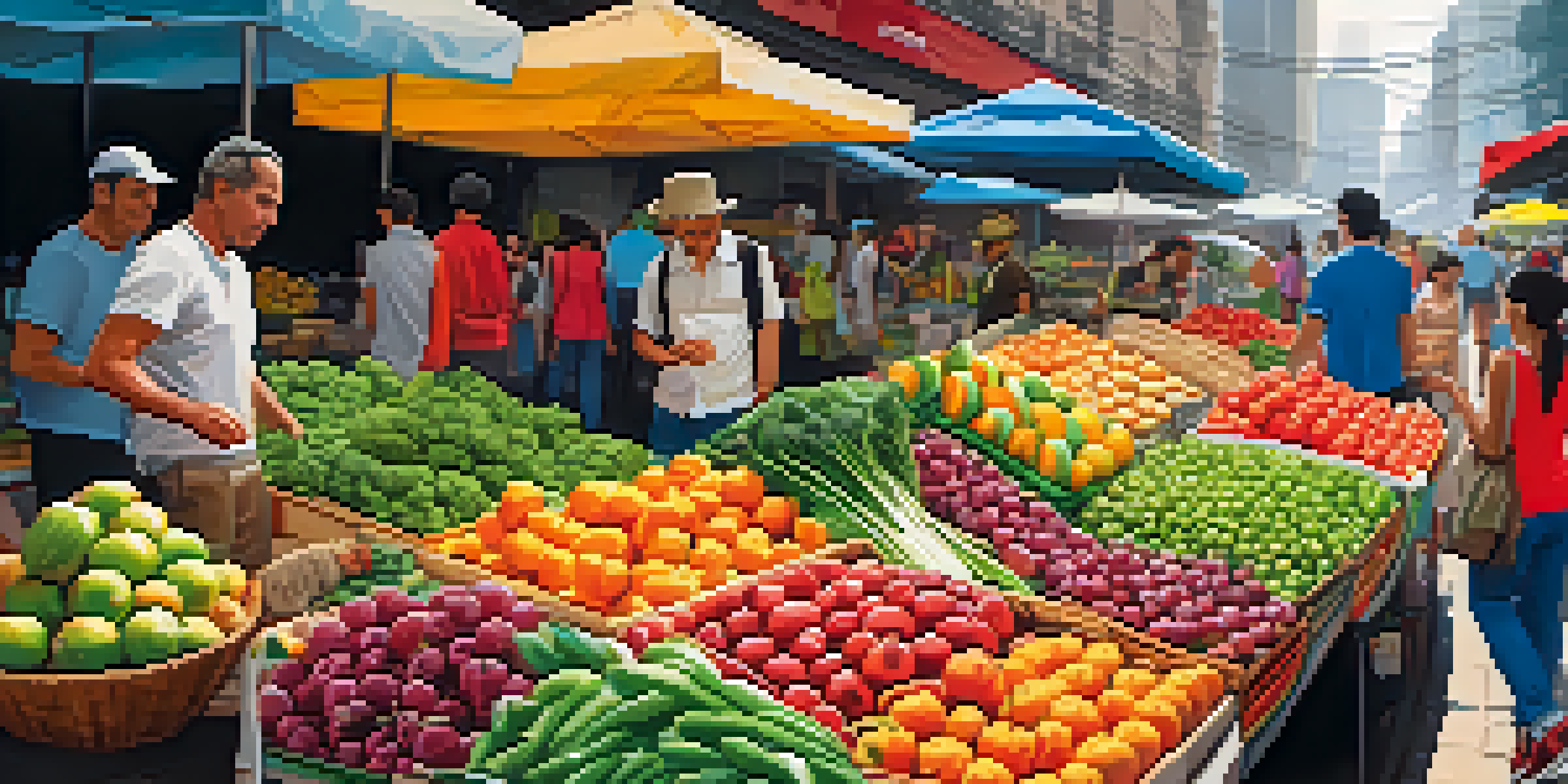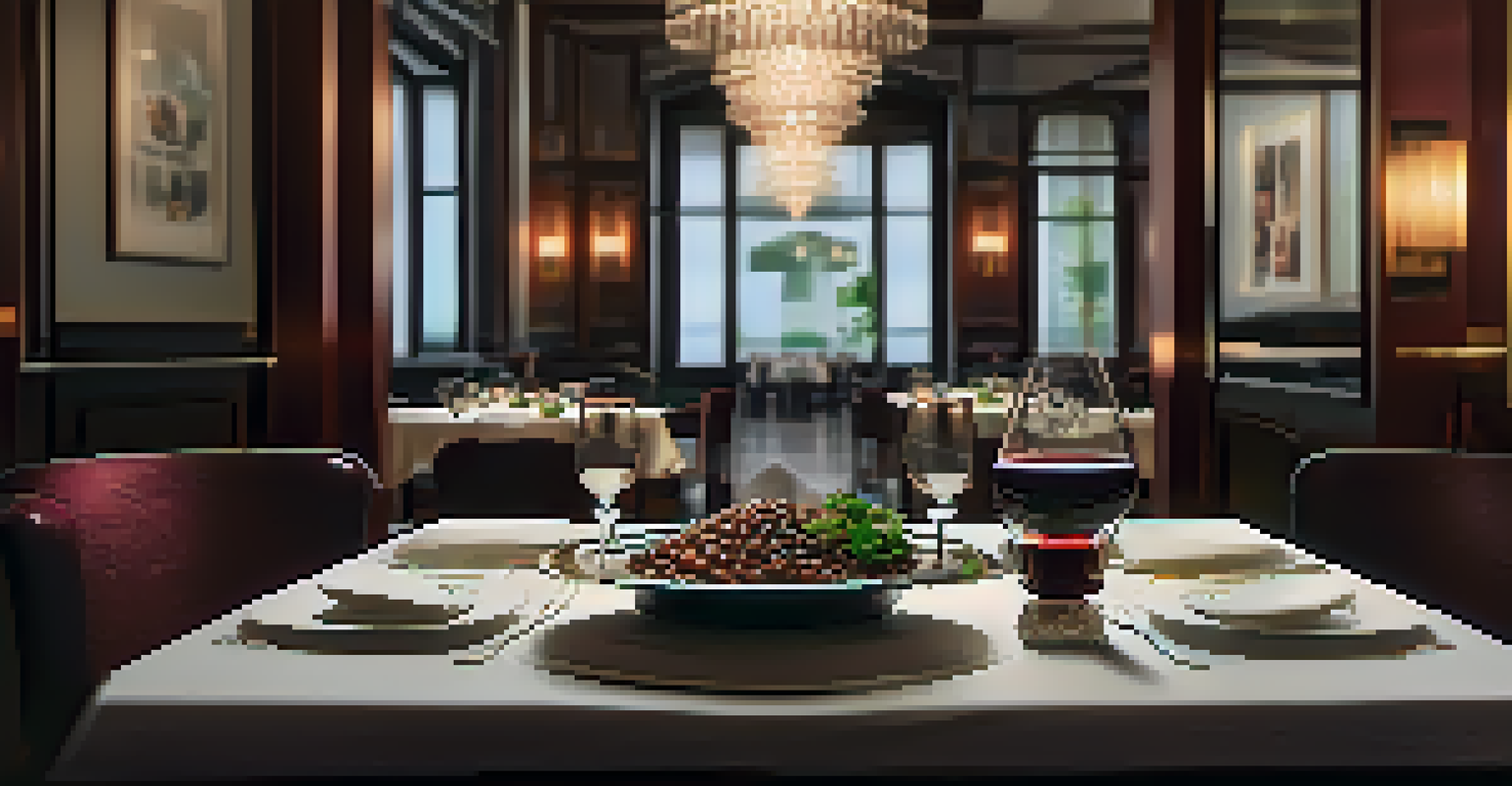Exploring the Gastronomic Richness of São Paulo

A Melting Pot of Cultures: São Paulo's Unique Culinary Identity
São Paulo is often described as a melting pot, and its culinary scene is a perfect reflection of this. The city attracts people from all over the world, bringing their food traditions and flavors along. This blend results in a unique gastronomic identity that showcases everything from Italian pasta to Japanese sushi, all within a few blocks.
Food is our common ground, a universal experience.
You can stroll through the streets of the city and find an Italian pizzeria right next to a traditional Brazilian boteco. This vibrant mix not only highlights the diversity of São Paulo but also encourages culinary experimentation. Chefs are constantly innovating, creating fusion dishes that draw from various cultures, making each meal an adventure.
For food lovers, São Paulo offers a chance to taste the world without leaving the city. Sampling these diverse cuisines can help you appreciate the stories behind each dish and the people who brought them here. It's a reminder that food can be a bridge between cultures, fostering understanding and connection.
Street Food: The Heartbeat of São Paulo's Culinary Scene
No exploration of São Paulo's food culture would be complete without mentioning its street food. Vendors line the streets, offering an array of delicious, affordable options that reflect the city's vibrant lifestyle. From the famous pastéis—crispy pastries filled with savory goodies—to the mouth-watering pão de queijo, there's something for everyone.

Street food in São Paulo is more than just a quick meal; it's an experience. For instance, trying a hot dog here is a whole new adventure, topped with unique ingredients like corn, mashed potatoes, and even quail eggs. These creative combinations are a testament to the local love for flavor and innovation.
Diverse Culinary Scene
São Paulo's food culture is a vibrant blend of global flavors, showcasing dishes from various ethnic communities.
Exploring the street food scene is an opportunity to engage with locals and understand their culinary preferences. It's a casual affair, where you can chat with vendors while savoring freshly prepared dishes. This lively atmosphere makes street food a true reflection of São Paulo's culture and community spirit.
Fine Dining: Where Tradition Meets Innovation
While street food captures the essence of everyday life, São Paulo's fine dining scene showcases the city's culinary prowess. High-end restaurants are helmed by talented chefs who blend traditional Brazilian ingredients with global techniques. This fusion results in dishes that are not only visually stunning but also bursting with flavor.
Cooking is like love. It should be entered into with abandon or not at all.
For example, a visit to a renowned restaurant may offer you a modern twist on feijoada, the classic Brazilian stew. Instead of the traditional preparation, chefs might incorporate unexpected elements, elevating the dish to new heights. Such innovation highlights the creativity that defines São Paulo's gastronomy.
Dining in these establishments is not just about the food; it's also about the experience. Many restaurants focus on creating a memorable atmosphere, offering exceptional service and thoughtfully curated wine pairings. This attention to detail ensures that every meal is a celebration of São Paulo's rich culinary landscape.
Cultural Influences: The Role of Ethnic Communities
São Paulo's culinary diversity is deeply rooted in the rich cultural tapestry woven by its various ethnic communities. The city is home to large Italian, Japanese, and Arab populations, each contributing their unique flavors and cooking techniques. This cultural influence can be seen in many dishes and restaurants throughout São Paulo.
For example, the Liberdade neighborhood is known for its vibrant Japanese culture, offering an array of sushi bars and ramen shops. Here, you can find authentic Japanese cuisine that reflects the community's traditions, yet is also adapted to local tastes. Similarly, the Italian influence is evident in the numerous pizzerias and pasta houses scattered across the city.
Street Food Experience
The city's street food offers a unique and engaging way to savor local flavors while connecting with the community.
These communities not only enrich the city's food scene but also create a sense of belonging and identity. By exploring São Paulo's neighborhoods, you can experience the flavors that have shaped the city's culinary landscape, making each bite a reflection of its diverse heritage.
Local Markets: A Haven for Fresh Ingredients
Local markets are a treasure trove for anyone interested in the culinary arts, offering a glimpse of the freshest ingredients that define São Paulo's cuisine. The Municipal Market, or Mercadão, is a must-visit for food lovers, featuring stalls brimming with vibrant fruits, vegetables, and spices. It's a sensory overload that invites you to explore and sample.
One of the market's star attractions is the mortadella sandwich, a colossal creation packed with layers of the savory cold cut. This iconic dish has become a symbol of the market and is a testament to the love of quality ingredients. Strolling through the aisles, you can also discover local cheeses, cured meats, and artisanal breads, all waiting to be tasted.
Shopping at these markets not only allows you to gather ingredients for your own culinary adventures but also supports local farmers and artisans. The lively atmosphere and the passion for quality food are contagious, making it a rewarding experience for anyone who appreciates good food.
Coffee Culture: Energizing São Paulo's Culinary Landscape
São Paulo's coffee culture is a vibrant and essential part of its culinary identity. With a rich history in coffee production, Brazil is one of the world's largest coffee producers, and the city takes great pride in its café scene. From cozy, artisanal cafés to bustling coffee shops, there's no shortage of options to enjoy a perfect cup.
In recent years, specialty coffee has gained traction, with baristas focusing on quality sourcing and unique brewing methods. This movement has transformed how locals experience coffee, encouraging them to appreciate flavors and aromas in new ways. Tasting single-origin coffees allows you to explore the nuances that different regions bring to your cup.
Fine Dining Innovation
São Paulo's fine dining combines traditional Brazilian ingredients with innovative techniques, creating memorable culinary experiences.
Visiting a local café not only offers a delicious caffeine fix but also a chance to soak in the city's atmosphere. Many cafés serve as social hubs, where friends gather to chat or work, often surrounded by the aroma of freshly brewed coffee. This communal aspect adds to the charm of São Paulo's coffee culture, making it an integral part of the city's culinary journey.
Desserts: Sweet Endings in São Paulo's Culinary Adventure
No culinary exploration is complete without indulging in desserts, and São Paulo has plenty to offer. From traditional Brazilian sweets to international confections, the city's dessert scene is as diverse as its food landscape. Popular treats like brigadeiro—chocolate truffles made with condensed milk—are not to be missed.
Another must-try is the pudim, a creamy caramel flan that melts in your mouth. These desserts are often homemade, reflecting the warmth of Brazilian hospitality and the importance of family traditions. Many local bakeries and dessert shops pride themselves on their unique takes on these classic treats.

Exploring desserts in São Paulo is a delightful way to wrap up your culinary journey. Whether indulging in a sweet treat from a street vendor or enjoying a beautifully plated dessert in a fine restaurant, each bite offers a taste of the city's rich culinary heritage. It's a sweet reminder that food is meant to be celebrated and shared.